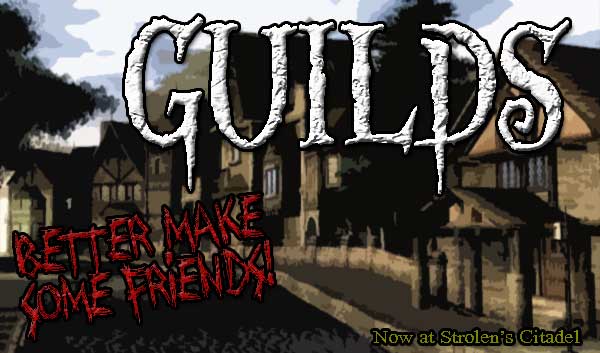Four Forges: A simple board game played by Dwarves
All dwarves in the Ven mountains are familiar with this simple game. Though elaborate and colorful game board have been craft, the game is simple enough that you could out line a board in the dirt and play with four handfuls of stones.
History:Â
Four Forges is as at least old as the oldest dwarven record of the Ven Mountain Dwarves. In the Chroniclers' Caves there are depictions of dwarves playing the game while camped among the baggage trains of the First Army. Â So popular was the game, that it has actually been banned by the church of droven at various times. Â The argument is that games are a distraction from real work and dwarves should not waste a single grain of their life on recreation. Â One church edict also detailed the corrupting nature of the game because it encourages dwarves to waste resources and our inhibit others from utilizing the resources. Â
But despite these past attack the game is still ubiquitous. Ale-wells, taverns and beer caves all have Forge boards and bags of stones for their patrons to use.  The Bronzebeards are famous for playing a version  of the game with gemstones in which each player keeps his 'chest' at the end of the game. Two generations ago having a finely crafted and precious Forge Board in your entry hall was considered a sign of status and taste among noble dwarves.  But you were just as likely to find Mountain Clan children playing the game in the dirt or laborers playing a round in their meeting halls.  It is such a part of dwarven society that its presence goes unnoticed.Â
Present Applications 'The Game of Death' and the Strength of the Guilds
In recent years it has been referred, specifically among the warrior clans, as the game of death. Â That is because the game is commonly played in hospices were old and warn dwarves no longer fit for labor wait for death. The stigma that this is game for old man and children is gaining some traction. Â It is a rare dwarf in the Ven Mountain that has never played forges, but it is no longer the popular past time that it once was. Â The Guild Council recently pointed to the decline of Forges popularity as evidence that Guilds as an institution promote hard work and are more efficient than the old system of serfdom and conscripted labor. Â To disclose fully, we Chroniclers still have two Forge boards in our eating hall and play regularly. Â Â
The Game:Â
Four Forges: The game is played on a 4 by 4 grid with 4 players. In many versions of the games the rows are painted different colors to define the 4 playing areas of the game. Each row is considered a forge. Each segment of the grid is considered an anvil. Each player has a forge made of 4 anvils, and 18 stones to start. The goal at the end of the games is to have the most stones in your 'chest' at the end of the game. The game ends when one player has no stones left in their forge.Â
Pieces:
72 stone
1 board
1 bag
Set up
Each player takes 18 stones, 6- black, 6-silver, 6-grey
Each player is assigned a forge on the board. There are four forges, ochre, malachite, lead and azurite. These should be chosen at random because azurite has an advantage.
SETUP
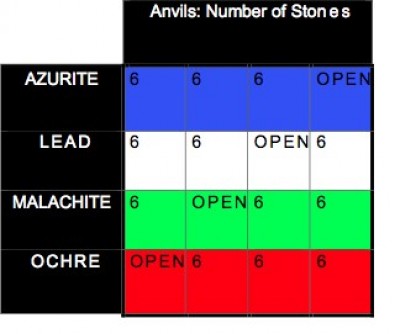
Each player then takes all 18 stones into a closed fist and lets six of each drop into three of his anvils randomly. The board should like the above diagram. You are ready to begin the game.
On their turn each player can take 4 actions. Those actions can be any combination of the following: forge, smelt, mine break or move. Or the player may trade with another player.
Moving: when moving a player can move 1 stone from one anvil to any adjacent anvil, including an anvil in different forge. Diagonal moves are illegal, and anvils 1 and 4 are not adjacent to each other.Â
Ochre is adjacent to Malachite and Azurite
Malachite is adjactent to Ochre and Lead
Lead is adjacent to Malachite and Azurite
Azurite is adjacent to Lead and Ochre.
Moving: The Lead player can move a stone from his second anvil to any of 4 anvils surrounding it. Anvils 1 and 4 only have 3 anvils adjacent
Forging: If an anvil has only three stones it and those stones are all identical the player can chose to FORGE. When forging the player moves two pieces from his anvil into his chest and one is left on the board.
Smelting:Â If player has only three pieces on one anvil and they each different colors, then all 3 are removed into his chest.
Breaking: A player may choose to destroy a single stone on any of his anvils regardless of how many stones are on the anvil. When a stone is broken it placed in the bag and does not count towards anyone's score.
Trading (optional rule). Instead of making any other moves a player may make a trade with another player. During a trade two player may exchange any number of stones, directly from one anvil to another regardless of where those anvils are on the board. But an exchange must be made and it is made directly between anvils. Thus Lead could move 8 stone from his 4th anvil to his Ochres 3rd anvil if the Ochre player agrees and the Ocrhe player has at least one stone in the third anvil to trade. If a player initiates a successful Trade he can make no other moves that turn.
Mining (optional rule): Â Another version of the game uses 72 additional stones equally divided between all the three colors that are kept in a bag called the 'mine'. Â As an action on a players turn they may choose to mine. Â Prior to mining a player must have an empty anvil, when a player mines they reach into the bag and randomly select 6 stones which are then placed on one of the mining player's empty anvils. Â Playing with mining changes the end point of the game, the game no longer ends once a player clears all his anvils. Â With this rule in effect their are two conditions for which the game may end. 1) The game ends when the current player can not make legal move or 2) the game ends when the current player has all his or her anvils clear and declares the game over. Â A player can only declare the game over if he or she has cleared all their anvils and it is currently their turn. Â Declaring the game over does not count as an action. Â When player has cleared all their anvils after taking all three of their actions that player they must either declare the game over or declare their turn over. Â Â Â
Order of play: Ochre, Malachite, Lead and Azurite.
Once a stone is legally removed from the board into a chest or the bag it can not be returned to the board for the duration of the game.
There is no maximum or minimum number of stones per anvil
Players can only take actions with the stones in his forge.
Player must take all three actions, a player may not pass. If any player can not take all three actions or trade the game ends.Â
Ending Game:
The game ends when the current player cannot take a legal action and has not taken all three actions on their turn or the game ends when the current player has cleared all their anvils and declares the game over. Â Declaring the game over does not count as an action.Â
SAMPLE TURNS:
Here is a sample board prior to any player actions, it is currently Ochre's turn.
Example 1: START
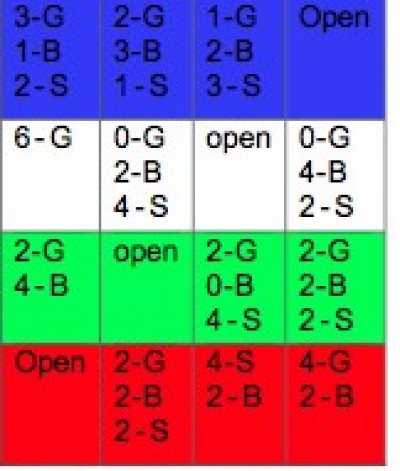
Example 1: FIRST MOVE
Ochre uses all three of his actions to move three stones from his 2nd anvil to his 1st anvil
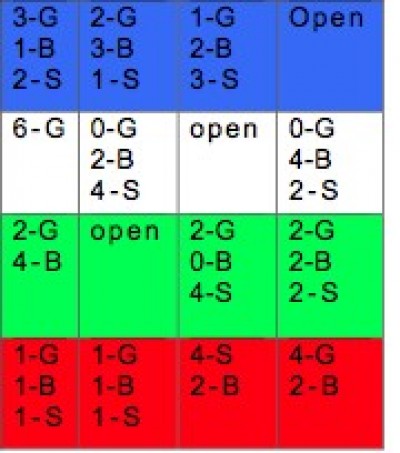
Example 2: Malachite's turn. Malachite noticed that Ocrhe now has two smelting pots in the 1st and 2nd anvils of his forge. He wishes to block Ochre's ability to smelt those stones. Thus he use two actions and moves 1 grey from his first forge to ocrhe's first forge, and one 1-G to his second forge.
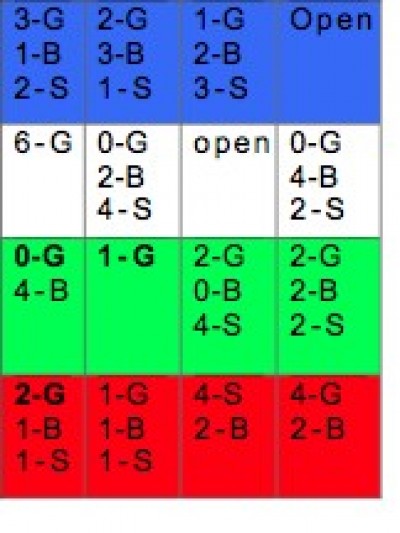
Example 2: Malachite still has one action left, so he moves that a Grey stone, the one he just moved into his 2nd anvil, from his 2nd anvil to Ochre's 2nd anvil. Malachite's turn is over, it is now Lead's turn.
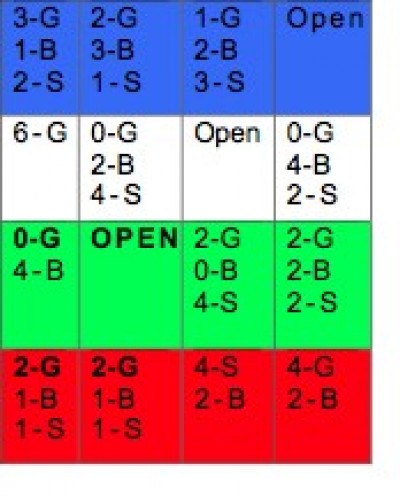
Example 3:
Later in the game it is Azurite's turn, Azurite has a smelting pot on anvil 3, and anvil 4 is one move away from a smelting pot.Â
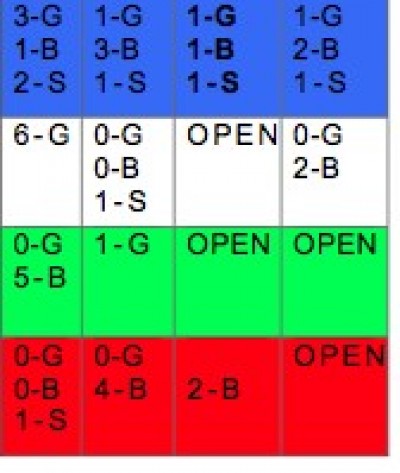
Example 3: Azurite smelted anvil 3 and placed the three stone in his chest. He then decides he will break one stone in anvil 4 rather than moving it. He breaks a black stone and places it out of play in the bag.
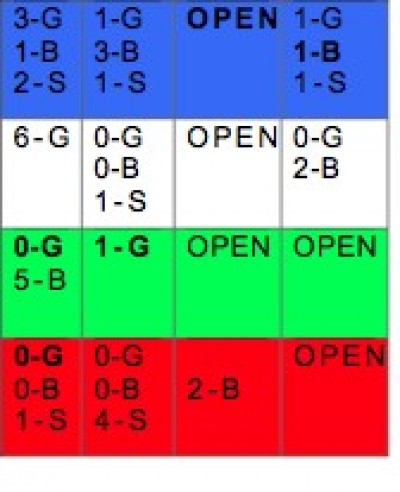
This will allow Azurite to place 3 more stone in his chest by smelting anvil 4 with his 3rd action.
Example 4: Directly following Azurite's turn in the previous example it is Ochre's turn. Ocrhe notices that Azurite's 2nd anvil and Malachite's 1st anvil are two move away from either being smelted or forged.Â
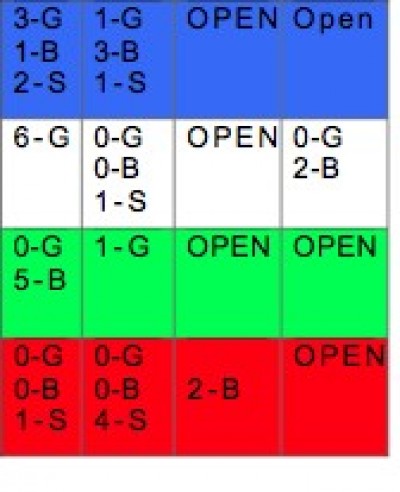
Example 4: Ochre's turn
Ochre's first action will be to move 1-silver from his 2nd anvil to azurite's 2nd anvil. This leaves him with 3 silver on his 2nd anvil which he forges with his second action and places two silver in his 'chest'.
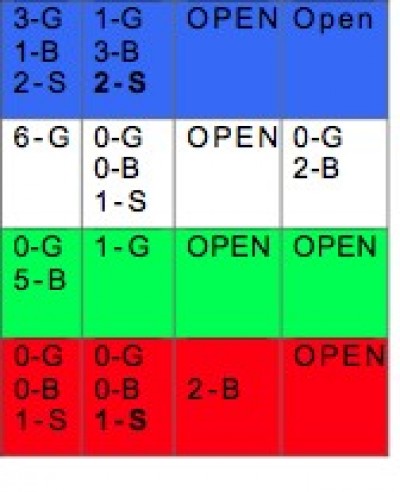
Example 4: Ochre's turn
Ochre uses his final action is to move a 1 black stone from his 3rd anvil to Malachite's 3rd anvil. This will leave him three stones in his forge, meaning as long as no one moves a stone to his forge, he will be able to end the game on his next turn. Â
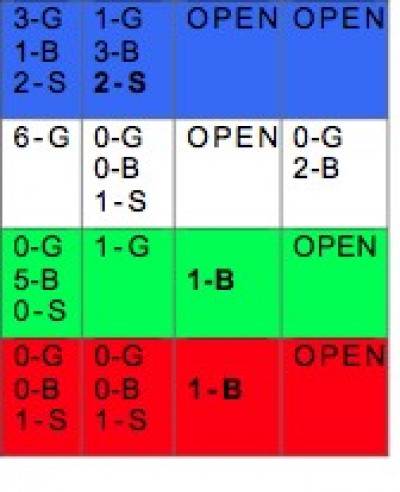
The idea for Strolen Citadel Guilds has been around since the site first began. There have been many thoughts about it and all of them revolved around A LOT of code with the features all, more or less, automated. Well, that won't happen so why fight my impulses.
So any submission that goes in for the next month with a Guild focused freetext will gain extra XP and the knowledge that you are here at the beginning of the Era of the Guilds!
Join or create a Guild today!
Not Registered Yet? No problem.
Do you want Strolenati super powers? Registering. That's how you get super powers! These are just a couple powers you receive with more to come as you participate.
- Upvote and give XP to encourage useful comments.
- Work on submissions in private or flag them for assistance.
- Earn XP and gain levels that give you more site abilities (super powers).
- You should register. All your friends are doing it!
? Responses (13)
A nice, simple game. But though I think that humans, elves, and so on would play more than dwarves (and possibly simply call the forges red, green, and so on), its a good sub. 4/5

thanks
Took me a second to get the hang of it but your description explained it very well. Will have to put this together with my eldest and see how it turns out!
Excellent background on the game as well. Felt it was perfect and gave a lot of personality to it. Great sub!

Crumb, out of votes for the day. Wondering why that was. 'I'll be back.'
CAN NOT GET THOSE SAMPLE BOARDS TO BE ANY SMALLER!
I am also very tempted to try this out with my boys! :-)
Great one axle! Although the game itself is simple, I'm sure that making up such a game from scratch, is less simple. It actually seems playable, and the background makes it come alive. The 'corrupting influence', and 'played in hospices'and so on are really nice touches.
Definitely a game I need to try out for myself, but a solid and wonderful sub. I like the descriptions of how dwarves of different ages/eras view the game. Great work!
Got my votes!!
I like this - and the use of graphics definitely helps!
Update: Funny you should HoH this today cause we play finally play tested this at board game gathering using risk pieces as stones and a board drawn on a wet erase grid map. It was ok, but after just one game we decided to add mining. Mining keeps a player from being isolated early in the game. We also found that it does not matter much if players start with 6 types of each stones or just a random 18 stone. The key to the game is table talk and horse trading.
just played with mining, it makes the game awful don't bother with mining
Neat! I would certainly try this out. Good to see you're play-testing it for functionality.
Instead of paint, I'm picturing a very dwarfy board made from the actual stones the colors represent.
One of the coolest mini-games I have ever seen. Definitely eager to try this out one day, and I would love to spring this on my players as part of a dwarven adventure.
